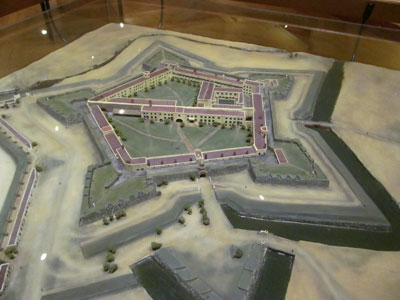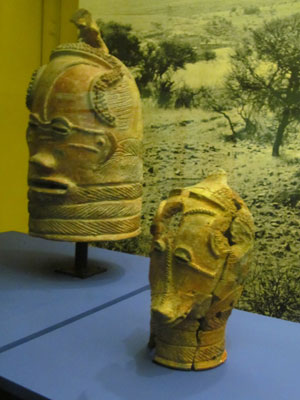Windows into Cape Town’s past
This item appears on page 56 of the June 2016 issue.
Most visitors to Cape Town in South Africa typically spend three or four days exploring the city and its environs. Among their must-see sights are Table Mountain, the Cape of Good Hope, the penguins near Simon’s Town, Kirstenbosch Garden, Groot Constantia and the Victoria & Alfred Waterfront.
These are among the top sights to visit, and well they should be. They make Cape Town special. But for those with more time and/or with an interest in history, there are several sights in Cape Town that should not be missed.
Rock art
At the top of the list is the Iziko South African Museum, a treasure trove of natural-history displays, but the main reason to visit is to see some of the oldest art in the world.
The southern San people, now extinct, were hunter-gatherers who lived in what is now South Africa at least as far back as 100,000 BC. In caves and in rock overhangs scattered throughout South Africa, between about 8000 BC and AD 400 they painted images and abstract designs on rock surfaces. Some of their rock art could even be far older.
In the South African Museum, visitors can see photographs, re-creations and actual rock art paintings, including the superb Linton Panel depicting shamans in a trance-like state as well as elands, animals considered sacred by the San.
In an adjacent room are the terra-cotta Lydenburg Heads, dating from between AD 500 and 800. They are among the earliest-known examples of African sculpture in Southern Africa and were found in the Transvaal region in northeastern South Africa.
The Iziko South African Museum (25 Queen Victoria Street, Gardens, Cape Town; phone +27 [0] 21 481 3800, www.iziko.org.za/museums/south-african-museum) is open daily 10 to 5. Admission costs ZAR30 (about $2).
The southern San people, the creators of the rock art, fell victim to other tribal groups about 2,000 years ago, the sheep-herding Khoekhoen and the cattle-herding Nguni, who both migrated from the north, displacing the San. Then, 1,600 years later, Europeans arrived, completing the displacement and destruction begun by the Khoekhoen and Nguni.
Colonial fortress
The Dutchman Jan van Riebeeck arrived in what is now Cape Town in 1652 to set up a way station for the Dutch East India Company. He constructed a mud-and-timber fort beside the sea, the Fort of Good Hope. This fort was soon replaced (1666-1679) by a sturdier stone pentagonal fortress with defensive bastions jutting out from its five corners.
In 1685, a cross section, called a kat in Dutch, was built, bisecting the huge fortress courtyard into outer and inner sections. This cross section became impressive residences for the fort’s governor and his second-in-command.
The Fort of Good Hope, also called the Castle of Good Hope, is the oldest building in South Africa. It now stands half a mile from the sea because of land reclamation, but it still has a partial moat that visitors cross to reach the entrance. The fort also still houses some military offices.
Within the outer courtyard is a military museum that covers 400 years of Cape military history, from Bartolomeu Dias’ first clash with the natives in 1488 to the South African war of 1899-1902, also called the Second Boer War, between Britain and South Africa.
The Governor’s Quarters houses the William Fehr collection of decorative arts, including furniture, paintings and glassware from Cape households of the 17th and 18th centuries. In the inner courtyard are a dolphin fountain, bakery and torture chamber.
Don’t miss the key ceremony at 10 a.m. and noon every day except Sunday. A key is ceremonially fetched from the Governor’s House to open a small wicket gate within the fort’s main gate. A bell is rung and a small cannon fired (no cannon firing on Saturday or Sunday).
The Castle of Good Hope (Darling St. & Buitenkant St., Cape Town, 8001, South Africa; phone +27 21 787 1260, www.castleofgoodhope.co.za) is open daily 9 to 4. Admission costs ZAR30.
Colonial veggies
At about the same time he constructed the fort, van Riebeeck also planted a large vegetable patch. This supplied Dutch East India ships with fresh food after their long voyage from Holland and before they continued around the Cape of Good Hope eastward to the Dutch East Indies.
This vegetable garden, called the Company’s Garden, became a botanical garden in the 18th century and is today a shady oasis of greenery and flowers in the middle of the city. Opposite the aviary is the Garden Tea room, where a mid-morning coffee or an afternoon cup of tea (try South Africa’s unique herbal rooibos tea) can be enjoyed away from the city bustle.
The main entrance of the Company’s Garden (19 Queen Victoria St., Cape Town; phone +27 21 426 1357) is on Wale Street, but the garden can also be entered at many other points. It’s open daily from 7 to 7, with no admission charge.
Colonial slaves
Steps away from the Company’s Garden’s main entrance is the Slave Lodge, one of Cape Town’s most notorious buildings.
Labor was needed for the fledgling colony, and it was slaves who provided that labor. They were captured primarily from East Africa, Madagascar, India, Sri Lanka, Indonesia and Malaysia. Those slaves “owned” by the Dutch East India Company were housed in the Slave Lodge, constructed between 1660 and 1679.
As many as 1,000 slaves were crammed in at one time, and it is estimated that as many as 20% died each year from the wretched conditions. Those who survived were sold just around the corner from the Slave Lodge. A small plaque marks the spot on Spin Street where slaves were traded beneath what was called “the slave tree.”
The Slave Lodge chronicles the history of the Cape slaves and their descendants. There’s a poignant lighted column with the names of some of the slaves. Names like Cupido van Bengalen, Abasemlie van Zanzibar, Javaan van Java and Hemijne van Madagascar tell you where they originally came from.
The Slave Lodge (49 Adderley St., Cape Town; phone +27 [0] 21 467 7229, www.iziko.org.za/museums/slave-lodge) is open 10 to 5, Monday to Saturday. Admission costs ZAR30.
Private home
One hundred years after the construction of the Castle of Good Hope and the Slave Lodge, life had changed a great deal in Cape Town. It had grown in size and population, with many wealthy government officials, tradesmen and professionals who wanted grander residences for themselves. For a sample of how well-to-do Cape Towners lived, visit the Rust en Vreugd (Peace and Joy) House.
Built in 1777-1778, this was once the home of the public prosecutor, Willem Cornelis Boers, one of Cape Town’s most important officials. From 1814 to 1826 it was also the home of the English governor when Cape Town became a British colony in 1814.
A period garden, with spacious lawn, herbaceous borders and a lovely gazebo, surrounds the elegant house, with its two porches one above the other. Part of the William Fehr Collection, including the illustrations of 19th-century English artist Thomas Baines, are now housed there.
The Rust en Vreugd (78 Buitenkant St., Cape Town; phone +27 [0] 21 481 3903, www.iziko.org.za/museums/rust-en-vreugd) is open 9 to 5, Monday to Friday. Admission costs ZAR20 (about $1.40).


